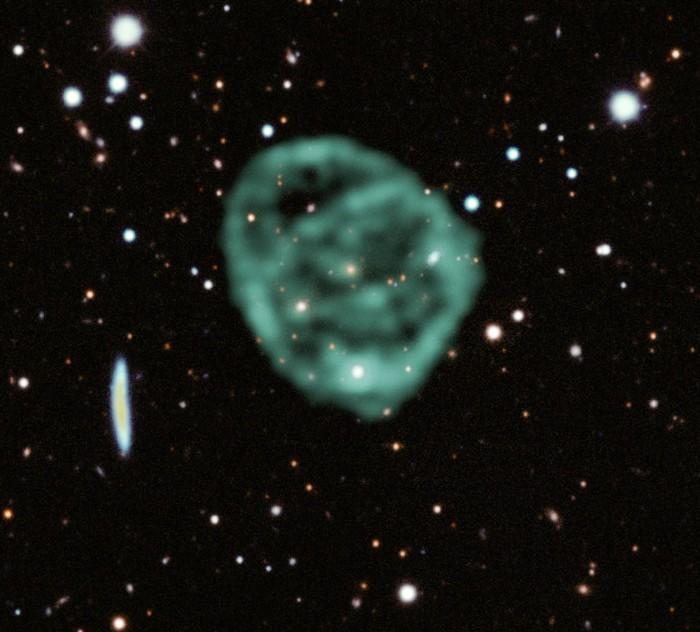Elusive Space Object Imaged with Unprecedented Precision

The outer circle of Odd Radio Circles. Source: Nature.
Odd Radio Circles (ORCs) are mysterious gigantic rings of radio waves in space. Astronomers are still not sure about the origin of such a gigantic space object with only a few ORCs imaged or sighted so far.
Recently, one such ORC was captured with an unprecedented resolution. Named ORC J2103-6200, or the ORC1, it was captured with the help of MeerKAT radio telescope in South Africa. The high-resolution radio telescope provided unprecedented information about rare events. The details have been published in the preprint server arXiv and will soon appear in the journal Monthly Notices of Royal Astronomical Society. This has also sparked a new light on the origin of such space objects.
The MeerKAT radio data revealed that the larger outer circle of ORC1 is as huge as million light years across, which is nearly 10 times the diameter of the Milky Way. The ORC1 also has a series of smaller rings inside. “This discovery will start new scientific research among astronomers”, Alice Pasetto, a radio astronomer at the National Autonomous University of Mexico, said about the findings.
The first three ORCs, which include the ORC1, were discovered by the ASKAP (Australian Square Kilometre Array Pathfinder) telescope back in 2019. The fourth was identified by Giant Metre Wave Radio Telescope in 2013. Notably, the Giant Meter Wave Radio Telescope, located near Pune, consists of 30 full-steerable parabolic dishes with a diameter of 45 metre and observes at metre wavelength.
The fifth ORC was discovered last year by Barbel Koribalski with newer ASKAP data. Koribalski is a radio astronomer at Commonwealth Scientific and Industrial Research Organisation, Sydney, Australia.
The interesting part of ORCs is that each of them has a galaxy at the centre and astronomers believe that it might have something to do with the origin of the space object. The other interesting and rather puzzling fact is that ORCs could be detected only in radio wavelengths, not by optical or X-ray telescopes.
Regarding the elusive origin of ORCs, researchers and astronomers have three theories. According to the first theory, these objects were created from a shockwave at the centre of the galaxy.
The second theory postulates that they have were created from the activities of an active galactic nucleus having radio jets. The radio jets are materials that spew from the centre of some galaxies at a speed close to the speed of light. These radio jets also emit strong radio waves. The third theory says that ORCs are created by starbursts at the centre of their galaxies.
Koribalski said, “Like a detective, we’re gathering more and more clues as to what this object possibly could be.” Most ORCs have been found by the ASKAP telescope system because of its huge field of view. Generally, radio telescopes can view an area that is equal to the size of the Moon. But ASKAP has a 100 times bigger capacity. ASKAP found ORC1 and MeerKAT was used to analyse it in more detail as the telescope has a much higher resolution.
“The ORC project is a great example of the clever use of MeerKAT by its users playing to its strengths: ASKAP observes large swathes of the sky and can discover relatively rare types of objects; MeerKAT can then follow up to study them in greater detail,” said Fernando Camilo, who is the chief scientist at the South African Radio Astronomy Observatory, which built MeerKAT and also operates it.
Get the latest reports & analysis with people's perspective on Protests, movements & deep analytical videos, discussions of the current affairs in your Telegram app. Subscribe to NewsClick's Telegram channel & get Real-Time updates on stories, as they get published on our website.















